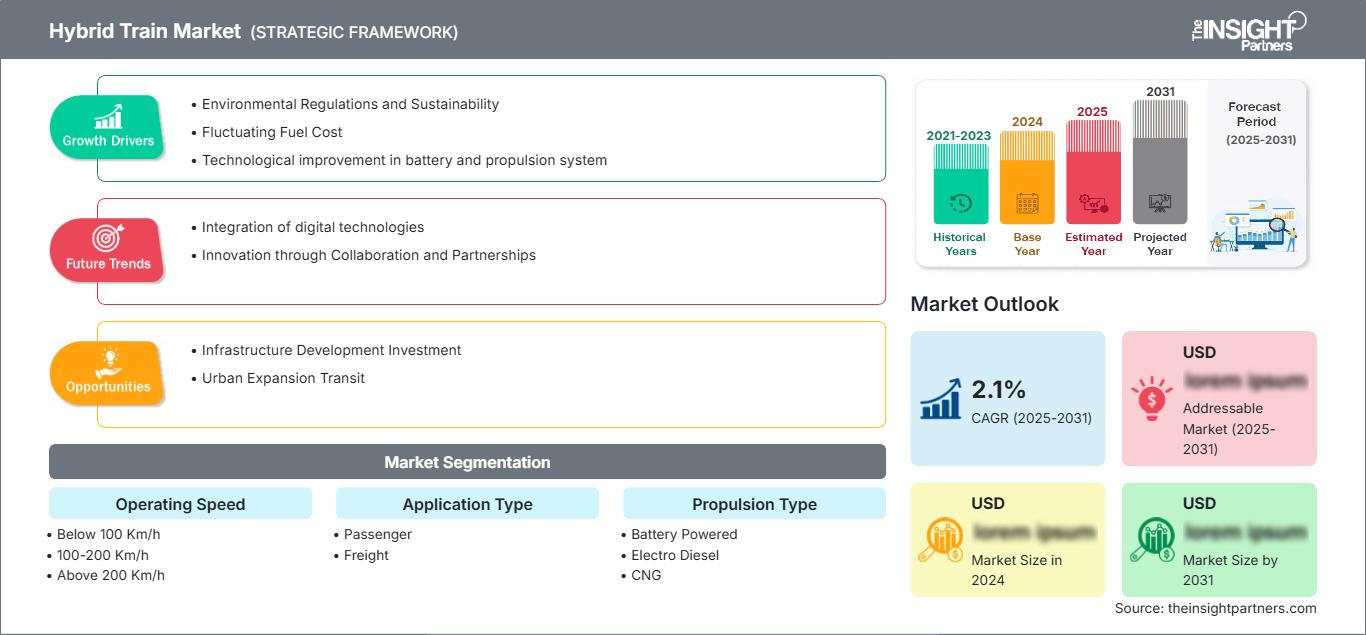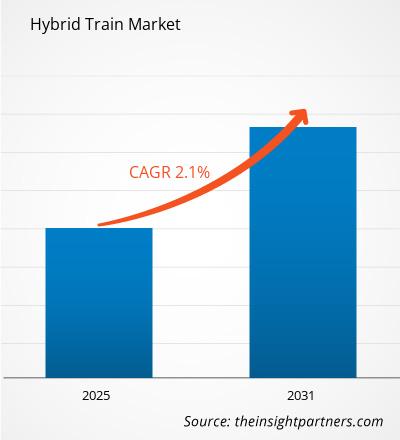Der Markt für Hybridzüge wird bis 2031 voraussichtlich ein Volumen von 23,35 Milliarden US-Dollar erreichen. Für den Zeitraum 2025–2031 wird ein jährliches Wachstum von 6,9 % erwartet.
Der Bericht ist segmentiert nach Betriebsgeschwindigkeit (unter 100 km/h, 100–200 km/h, über 200 km/h), Anwendungsbereich (Personenverkehr, Güterverkehr) und Antriebsart (Batteriebetrieben, Elektro-Diesel, CNG, LNG, Solar, Wasserstoff). Die globale Analyse wird zudem auf regionaler Ebene und für wichtige Länder aufgeschlüsselt. Der Bericht enthält die Werte in US-Dollar für die oben genannten Analysen und Segmente.
Zweck des Berichts
Der Bericht „Hybridzugmarkt“ von The Insight Partners beschreibt die aktuelle Marktlage und das zukünftige Wachstum sowie die wichtigsten Triebkräfte, Herausforderungen und Chancen. Dies wird verschiedenen Akteuren im Geschäftsbereich Einblicke ermöglichen, wie beispielsweise:
- Technologieanbieter/Hersteller: Um die sich entwickelnde Marktdynamik zu verstehen und potenzielle Wachstumschancen zu erkennen, können sie fundierte strategische Entscheidungen treffen.
- Investoren: Um eine umfassende Trendanalyse hinsichtlich Marktwachstumsrate, Finanzprognosen und Chancen entlang der Wertschöpfungskette durchzuführen.
- Regulierungsbehörden: Um Richtlinien zu regulieren und Aktivitäten auf dem Markt zu überwachen, mit dem Ziel, Missbrauch zu minimieren, das Vertrauen der Anleger zu wahren und die Integrität und Stabilität des Marktes zu gewährleisten. Marktsegmentierung für Hybridzüge: Betriebsgeschwindigkeit
- Unter 100 km/h
- 100–200 km/h
- Über 200 km/h
Anwendungstyp
- Personenverkehr
- Güterverkehr
Antriebsart
- Batteriebetrieben
- Elektro-Diesel
- CNG
- LNG
- Solar
- Wasserstoff
Geografie
- Nordamerika
- Europa
- Asien-Pazifik
- Süd- und Mittelamerika
- Naher Osten und Afrika
Passen Sie diesen Bericht Ihren Anforderungen anSie erhalten kostenlos Anpassungen an jedem Bericht, einschließlich Teilen dieses Berichts oder einer Analyse auf Länderebene, eines Excel-Datenpakets sowie tolle Angebote und Rabatte für Start-ups und Universitäten.
Markt für Hybridzüge: Strategische Einblicke

- Holen Sie sich die wichtigsten Markttrends aus diesem Bericht.Dieses KOSTENLOSE Beispiel umfasst Datenanalysen, die von Markttrends bis hin zu Schätzungen und Prognosen reichen.
Wachstumstreiber für den Hybridzugmarkt
- Umweltauflagen und Nachhaltigkeit: Der weltweit zunehmende Fokus auf CO₂-Emissionen und umweltfreundlichere Transportmittel ist einer der Haupttreiber für den Hybridzugmarkt. Regierungen weltweit setzen strenge Umweltauflagen durch, um die Luftverschmutzung zu reduzieren und ihre Klimaziele zu erreichen. Hybridzüge, die konventionelle Dieselmotoren und elektrische Antriebssysteme kombinieren, tragen wesentlich zur Reduzierung von Treibhausgasen und Kraftstoffverbrauch bei. Sie sind daher eine gute Option für Bahnbetreiber. Der regulatorische Impuls fördert Investitionen in Hybridtechnologie und beschleunigt das Marktwachstum, da die Betreiber die Umweltstandards erreichen wollen.
- Schwankende Kraftstoffkosten: Aufgrund schwankender Kraftstoffpreise suchen Bahnbetreiber nach Alternativen zu herkömmlichen Diesellokomotiven. Hybridzüge können helfen, Kraftstoff zu sparen. Sie können in Städten oder bei niedrigen Geschwindigkeiten elektrisch betrieben werden und benötigen Diesel nur für längere Strecken. Das bedeutet, dass Hybridzüge während der Fahrt Kraftstoff sparen und somit langfristig kostengünstig sind. Da die Treibstoffpreise weiter steigen, wird auch der Bedarf an Hybridzügen und damit das Marktwachstum weiter zunehmen.
- Technologische Verbesserungen bei Batterie- und Antriebssystemen: Hybridzüge weisen dank der jüngsten Entwicklungen in der Batterietechnologie und bei Antriebssystemen eine verbesserte Leistung und Effizienz auf. Fortschritte wie Lithium-Ionen-Batterien mit höherer Energiedichte und schnelleren Laderaten ermöglichen es Hybridzügen, länger elektrisch zu fahren. Verbesserungen bei regenerativen Bremssystemen ermöglichen die Rückgewinnung von mehr Energie beim Bremsen und erhöhen somit die Effizienz. Diese technologischen Fortschritte tragen zur Verbesserung der Betriebsleistung von Hybridzügen bei und eröffnen den Bahnbetreibern die Möglichkeiten zur Modernisierung ihres Fuhrparks.
Zukunftstrends im Markt für Hybridzüge
- Integration digitaler Technologien: Hybridzüge werden zunehmend mit fortschrittlichen Überwachungs- und Diagnosesystemen ausgestattet, um ihre Leistung und Wartung zu optimieren. Diese Systeme ermöglichen die Echtzeit-Überwachung des Betriebs sowie des Zug- und Batterieverbrauchs und ebnen so den Weg für eine proaktive Wartung und Effizienzsteigerung. Aufgrund intelligenter Technologien in Hybridzügen wird die Nachfrage in der Bahnindustrie steigen, da die Digitalisierung positive Auswirkungen auf die betriebliche Effizienz hat.
- Innovation durch Zusammenarbeit und Partnerschaften: Der Trend zur Zusammenarbeit zwischen Bahnbetreibern, Herstellern und Technologieanbietern bei der Entwicklung von Hybridzügen ist bemerkenswert. Die auf Forschung und Entwicklung basierenden Partnerschaften integrieren neueste technologische Merkmale in den Bereichen Energieeffizienz, Sicherheit und Leistung, um immer fortschrittlichere Hybridsysteme zu schaffen. Dadurch beschleunigt die Zusammenarbeit den Innovationsprozess und macht Hybridzüge gleichzeitig wettbewerbsfähig. Der Markt für Hybridzüge ist sehr vielversprechend, da die Akteure gemeinsam Herausforderungen bewältigen, Kompetenzen stärken und zum Wachstum beitragen.
Marktchancen für Hybridzüge
- Investitionen in die Infrastrukturentwicklung: Ein besserer Zugang zur Bahninfrastruktur ist ein weiterer schnell wachsender Bereich mit großem Potenzial für den Markt für Hybridzüge. Viele Länder investieren in die Modernisierung ihrer Schienennetze, um Konnektivität und Effizienz zu verbessern. Dies schließt auch Hybridzugsysteme ein. Solche Investitionen haben Herstellern die Möglichkeit eröffnet, Hybridzüge und die dazugehörigen Technologien anzubieten. Partnerschaften mit Regierungen und privaten Organisationen können zudem den notwendigen Ausbau der Ladeinfrastruktur in diesen Regionen ermöglichen und so die Nutzung von Hybridzügen weiter fördern.
- Stadterweiterung im öffentlichen Nahverkehr: Angesichts einer wachsenden Stadtbevölkerung müssen Städte Wege finden, den Verkehr nachhaltiger zu gestalten und gleichzeitig Staus und Emissionen zu reduzieren. Hybridzüge im Stadt- und S-Bahn-Verkehr bieten die Chance, ein integraler Bestandteil dieses Systems zu werden. Daher besteht die Möglichkeit, maßgeschneiderte Lösungen für Hybridzüge zu entwickeln, die auf den städtischen Raum abgestimmt sind und so ein umweltfreundlicheres öffentliches Verkehrssystem ermöglichen. Dies eröffnet einen zunehmend großen Nischenmarkt rund um die Modernisierung des öffentlichen Nahverkehrs.
Markt für Hybridzüge
Die regionalen Trends und Einflussfaktoren auf den Markt für Hybridzüge im gesamten Prognosezeitraum wurden von den Analysten von The Insight Partners ausführlich erläutert. Dieser Abschnitt behandelt außerdem die Marktsegmente und die geografische Verteilung des Marktes für das Management von Herzrhythmusstörungen in Nordamerika, Europa, dem asiatisch-pazifischen Raum, dem Nahen Osten und Afrika sowie Süd- und Mittelamerika.
Umfang des Marktberichts zu Hybridzügen
Berichtsattribut Einzelheiten Marktgröße in 2024 US$ XX Billion Marktgröße nach 2031 US$ 23.35 Billion Globale CAGR (2025 - 2031) 6.9% Historische Daten 2021-2023 Prognosezeitraum 2025-2031 Abgedeckte Segmente By Betriebsgeschwindigkeit - Unter 100 km/h
- 100–200 km/h
- Über 200 km/h
- Passagier
- Fracht
- Batteriebetrieben
- Elektrodiesel
- CNG
- LNG
- Solar
- Wasserstoff
- Nordamerika
- Europa
- Asien-Pazifik
- Süd- und Mittelamerika
- Naher Osten und Afrika
Abgedeckte Regionen und Länder Nordamerika - USA
- Kanada
- Mexiko
- Großbritannien
- Deutschland
- Frankreich
- Russland
- Italien
- Restliches Europa
- China
- Indien
- Japan
- Australien
- Restlicher Asien-Pazifik
- Brasilien
- Argentinien
- Restliches Süd- und Mittelamerika
- Südafrika
- Saudi-Arabien
- Vereinigte Arabische Emirate
- Restlicher Naher Osten und Afrika
Marktführer und wichtige Unternehmensprofile - Alstom
- Bombardier
- Construcciones y Auxiliar de Ferrocarriles
- Cummins Inc.
- GENERAL ELECTRIC
- HYUNDAI ROTEM COMPANY
- Kawasaki Heavy Industries, Ltd.
- Siemens
- Toshiba India Pvt. Ltd
Dichte der Akteure im Markt für Hybridzüge: Auswirkungen auf die Geschäftsdynamik
Der Markt für Hybridzüge wächst rasant, angetrieben durch die steigende Nachfrage der Endverbraucher. Gründe hierfür sind unter anderem sich wandelnde Verbraucherpräferenzen, technologische Fortschritte und ein wachsendes Bewusstsein für die Vorteile des Produkts. Mit steigender Nachfrage erweitern Unternehmen ihr Angebot, entwickeln innovative Lösungen, um den Kundenbedürfnissen gerecht zu werden, und nutzen neue Trends, was das Marktwachstum weiter ankurbelt.

- Holen Sie sich die Markt für Hybridzüge Übersicht der wichtigsten Akteure
Wichtigste Verkaufsargumente
- Umfassende Abdeckung: Der Bericht bietet eine umfassende Analyse der Produkte, Dienstleistungen, Typen und Endnutzer des Hybridzugmarktes und vermittelt so ein ganzheitliches Bild.
- Expertenanalyse: Der Bericht basiert auf dem fundierten Wissen von Branchenexperten und Analysten.
- Aktuelle Informationen: Der Bericht gewährleistet Geschäftsrelevanz durch die Berücksichtigung aktueller Informationen und Datentrends.
- Anpassungsmöglichkeiten: Dieser Bericht kann an spezifische Kundenanforderungen angepasst werden und sich optimal in die Geschäftsstrategien integrieren.
Der Forschungsbericht zum Hybridzugmarkt kann somit maßgeblich dazu beitragen, das Branchenszenario und die Wachstumsaussichten zu entschlüsseln und zu verstehen. Auch wenn einige berechtigte Bedenken bestehen, überwiegen die Vorteile dieses Berichts insgesamt die Nachteile.
- Historische Analyse (2 Jahre), Basisjahr, Prognose (7 Jahre) mit CAGR
- PEST- und SWOT-Analyse
- Marktgröße Wert/Volumen – Global, Regional, Land
- Branchen- und Wettbewerbslandschaft
- Excel-Datensatz
Aktuelle Berichte
Erfahrungsberichte
Grund zum Kauf
- Fundierte Entscheidungsfindung
- Marktdynamik verstehen
- Wettbewerbsanalyse
- Kundeneinblicke
- Marktprognosen
- Risikominimierung
- Strategische Planung
- Investitionsbegründung
- Identifizierung neuer Märkte
- Verbesserung von Marketingstrategien
- Steigerung der Betriebseffizienz
- Anpassung an regulatorische Trends




















 Kostenlose Probe anfordern für - Markt für Hybridzüge
Kostenlose Probe anfordern für - Markt für Hybridzüge